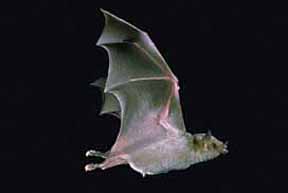Leptonycteris
| Leptonycteris | ||||||||||||
|---|---|---|---|---|---|---|---|---|---|---|---|---|

Large Mexican flower bat ( Leptonycteris nivalis ) |
||||||||||||
| Systematics | ||||||||||||
|
||||||||||||
| Scientific name | ||||||||||||
| Leptonycteris | ||||||||||||
| Lydekker , 1891 |
Leptonycteris is a bat genus in the subfamily of flowering bats (Glossophaginae) with three species that occur from southern North America to northern South America . They are absent on the West Indies , with the exception of smaller islands off the coast of South America.
features
The species are generally similar in physique to the other flower bats. They mainly differed in the construction of the dentition. In the Leptonycteris species, the lower incisors are present, while the third molar in the lower halves of the jaw is absent. These bats reach a head-torso length of 70 to 95 mm, a forearm length of 46 to 57 mm and a weight of 18 to 30 g. The color of the fur varies in different shades of brown. Like the other blossom bats, the species have a long tongue, the tip of which is covered with brush-like papillae. The narrow tail fly skin (uropatagium) is also characteristic.
Species, distribution and status
The following species belong to the genus.
- The Curaçao flower bat ( Leptonycteris curasoae ) lives in northern Colombia and Venezuela as well as on the islands of Curaçao , Aruba and Bonaire . It is considered to be endangered ( Vulnerable ).
- The distribution area of the large Mexican flower bat ( Leptonycteris nivalis ) extends from the southwest of the USA ( Arizona , New Mexico , Texas ) over Mexico to Guatemala . The species is as endangered ( Endangered listings).
- The small Mexican flower bat ( Leptonycteris yerbabuenae ) also reaches the southwest of the USA in the north and is also found on the Baja California peninsula and in the south as far as Honduras . It is considered to be endangered ( Vulnerable ).
Way of life
The choice of habitat varies between species. While Leptonycteris nivalis is predominantly in mixed forests, Leptonycteris curasoae prefers bushes with isolated cacti of the genus Pachycereus . Leptonycteris yerbabuenae mostly inhabits dry landscapes with bushes, trees and agaves .
The species form large colonies with 10,000 or more individuals at their resting places in caves, tunnels or buildings . They go for food late in the evening and mainly eat nectar , pollen and fruit. Occasionally they ingest smaller insects that remain in the digestive tract. Northern populations of the two Mexican species migrate to southern areas of the range in autumn. Seasonal migrations have also been recorded in various populations of the Curacao blossom bat.
In all three species, before the young are born, females form their own colonies that are separate from the males. A litter normally consists of one young animal that weighs about 7 g at birth. Females suckle their young for four to eight weeks.
Individual evidence
- ↑ a b c d Ronald M. Nowak: Walker's Mammals of the World. Volume 1. 6th edition. Johns Hopkins University Press, Baltimore MD et al. 1999, pp. 371-372, ISBN 0-8018-5789-9 .
- ^ Wilson & Reeder (eds.): Mammal Species of the World . 3. Edition. Johns Hopkins University Press, Baltimore 2005, ISBN 0-8018-8221-4 ( Leptonycteris - English: untitled .).
- ↑ a b c Leptonycteris in the IUCN Red List of Threatened Species 2015. Retrieved June 6, 2016.